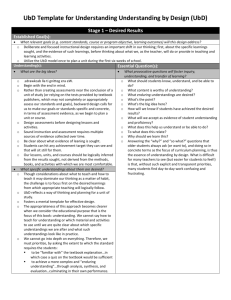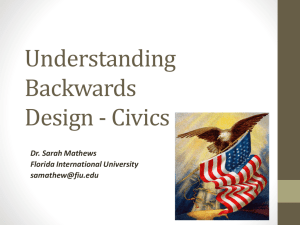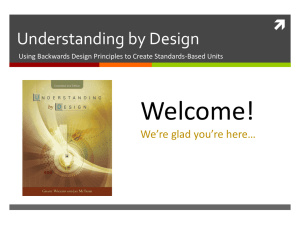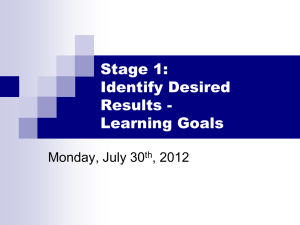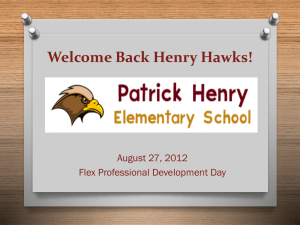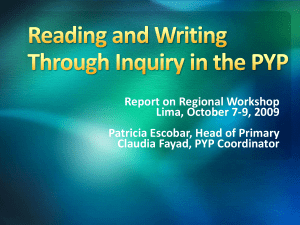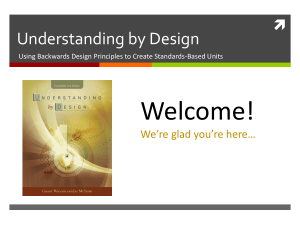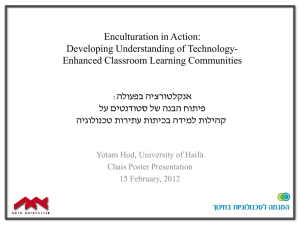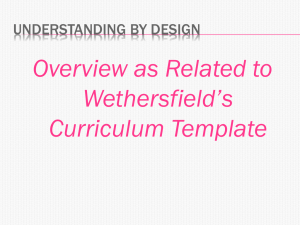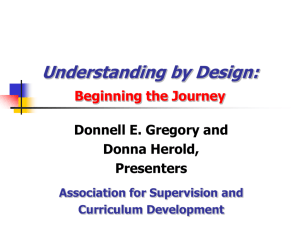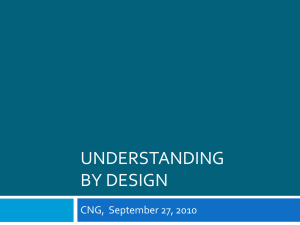OpeningPDAugust292012UbDDraft_5
advertisement
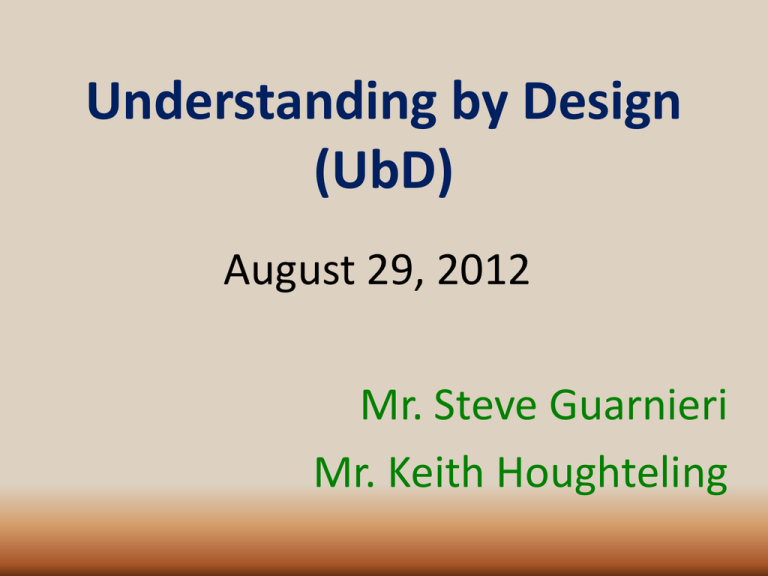
Understanding by Design (UbD) August 29, 2012 Mr. Steve Guarnieri Mr. Keith Houghteling Agenda • • • • • • • • Why Understanding by Design (UbD)? the Eight Tenets of Understanding by Design The Six Facets of Understanding Enduring Understandings and Essential Questions The Three Stages of Backwards Design Performance Tasks and the GRASPS model WHERETO Lesson Planning “What I Learned from Quentin Tarantino” Quotations “Only in education, never in the life of farmer, sailor, merchant, physician or scientist does knowledge mean primarily a store of information.” –John Dewey, Democracy and Education Assessments Assessment EPAS / Interim Assessments Performance Tasks Freshman Sophomore Junior EXPLORE— October, May (2) / Interim Assessments (2) 4 total PLAN—October, May (2) / Interim Assessments (2) 4 total ACT – October, March, APRIL (3) / 2 Interim Assessments 5 total Beginning of Year BOY EOY BOY EOY BOY EOY 2 total 2 total 2 total NOCTI Certification Tests The Constitution Test NOCTI Certification Tests Consumer Ed. NOCTI Certification Tests Consumer Ed. 7 8 5 (BOY) / End of Year (EOY) 2 total CTE / Content Area TOTAL minimum 6 Senior The Twin Sins of Curriculum Planning Activity-Oriented Teaching • Teachers plan and conduct various activities worrying only about whether they are engaging and studentfriendly. • These activities do not add up to coherent, focused, and generative learning. Cotton Candy—pleasant enough in the moment but lacking long-term substance. • • • • Content Coverage Marching through a resource (a textbook or literature) A teacher’s job is not to simply mention everything in a book or on a topic. Our job is to prioritize, make interesting and useful and “uncover” the content, not merely “cover” it. The textbook should serve as a resource, not a syllabus, in an effective and focused learning plan. the Eight Tenets of Understanding by Design (UbD) 1. UbD is a way of thinking purposefully about curricular planning and school reform. It offers a three-stage design process, a set of helpful design tools, and design standards—not a rigid program or prescriptive recipe. 2. The primary goal of UbD is student understanding—the ability to make meaning of “big ideas” and to transfer learning. 3. UbD unpacks and transforms content standards into the relevant Stage 1 elements and appropriate assessments in Stage 2. 4. Understanding is revealed when students autonomously transfer their learning through authentic performance. Six facets of understanding— the capacities to explain, interpret, apply, shift perspective, empathize, and self-assess — serve as indicators of understanding. the Eight Tenets of Understanding by Design (UbD) 5. Teachers are coaches of understanding, not mere purveyors of content or activity. They design for and support meaning-making and transfer by the learner and they adjust to achieve intended results based on constant monitoring. 6. Planning is best done backward from the desired results and the transfer tasks that embody the goals. The three stages (Desired Results, Evidence, Learning Plan) must align for the unit to be most effective. 7. Regular reviews of curriculum against design standards enhance curricular quality and effectiveness. 8. UbD reflects a continuous-improvement approach. The result of curriculum designs —student performance!— informs needed adjustments. Six Facets of Understanding Noun Forms • • • • • • Explanation Interpretation Application Perspective Empathy Self-Knowledge • • • • • • Verb Forms Explain Interpret Apply Shift Perspective Empathize Self-Assess / SelfKnowledge “Education: ‘That which discloses to the wise and disguises from the foolish their lack of understanding.’” –Ambrose Bierce (1842-1914), The Devil’s Dictionary Six Facets of Understanding Explanation Interpretation Application Perspective Empathy Selfknowledge demonstrate derive describe create analogies critique document adapt build create debug analyze argue compare contrast be like be open to believe be aware of realize recognize design exhibit express evaluate illustrate judge decide design exhibit criticize infer consider imagine relate reflect self-assess induce instruct justify make sense of make meaning of invent perform produce model predict prove show synthesize teach provide metaphors read between the lines represent tell a story of translate propose solve test use role play Enduring Understandings • An understanding is an inference, not a fact. • It is a helpful insight derived from inquiry. Key understandings in intellectual fields (e.g., in physics: Objects remain in motion at a constant velocity if no force acts on them) often violate common sense and conventional wisdom. • They are thus often prone to misunderstanding by students. Therefore, they cannot simply be “covered”; they must be “uncovered” (e.g., by exploring essential questions, wrestling with challenging problems, debating a complex issue). Enduring Understandings • Such understandings endure in that they enable us to make vital and informative connections in our learning—as students and as adults. For example, the idea that “might does not make right” applies to both playground disputes and international diplomacy. • Although facts and basic concepts can be learned in rote fashion, research shows that an understandingbased approach can yield more substantive, longterm, and flexible learning of the basics. Understandings function by helping to link and connect otherwise discrete facts and skills. Distinguishing Understandings from Factual Knowledge (76) •Consists of facts (e.g., 4 x 4 = 16) and basic concepts (e.g., sky). • Facts do not transfer. Basic concepts have limited transfer capacity (e.g., the concept of dog applies to different breeds). • Can be learned in a rote fashion (i.e., without understanding). • Can be assessed using objective test/quiz items having a “right” or “wrong” answer. • Reflect “big ideas” in the form of powerful generalizations. • Are transferrable across situations, places, and times. • Must be “earned” (i.e., constructed in the mind of the learner) through processes of inquiry, making inferences, and rethinking. • Are most appropriately assessed through performance tasks requiring one or more facets of understanding (e.g., application and explanation). Distinguishing Understandings from Factual Knowledge (76) Factual Knowledge Understandings •Consists of facts (e.g., 4 x 4 = 16) and basic concepts (e.g., sky). • Facts do not transfer. Basic concepts have limited transfer capacity (e.g., the concept of dog applies to different breeds). • Can be learned in a rote fashion (i.e., without understanding). • Can be assessed using objective test/quiz items having a “right” or “wrong” answer. • Reflect “big ideas” in the form of powerful generalizations. • Are transferrable across situations, places, and times. • Must be “earned” (i.e., constructed in the mind of the learner) through processes of inquiry, making inferences, and rethinking. • Are most appropriately assessed through performance tasks requiring one or more facets of understanding (e.g., application and explanation). Framing Understandings: Let’s Go to Work 1. In your table groups, list the common characteristics of Enduring Understandings. 2. Then, using your list, complete and compare responses to the Part 2 exercise: determining which of the six examples (11-16) are actually Enduring Understandings. The Three Stages of Backwards Design • Stage 1—Identify Desired Results • Stage 2—Determine the Assessment Evidence • Stage 3—Plan Learning Experiences and Instruction Stage 1—Identify Desired Results Established Goals Understandings: (U) Essential Questions: Students will understand that… Knowledge students acquire: Students will know… (Q) Skills students acquire: (S) (K) Students will be able to… What is the point of my unit? Essential Questions • What are the common characteristics of Essential Questions? • Discuss at your table (3-5 minutes). • After the discussion, we will share out. What are the characteristics of an essential question? Essential Questions Knowledge Questions 1. Are meant to be explored, argued, and continually revisited (and reflected upon). 2. Have various plausible answers. Often the answers to these questions raise new questions. 3. Should spark or provoke thought and stimulate students to engage in sustained inquiry and extended thinking. 4. Reflect genuine questions that real people seriously ask, either in their work or in their lives—not a “teacherly” question asked only in schools. 1. Have a specific, straightforward, unproblematic answer. 2. Are asked to prompt factual recall rather than to generate a sustained inquiry. 3. Are more likely to be asked by a teacher or a textbook than by a curious student or person out in the world. 4. Are more rhetorical than genuine. Essential Questions: Let’s Go to Work 1. In your table groups, list the common characteristics of Essential Questions. 2. Then, using your list, complete and compare responses to the Part 2 exercise: determining which of the six examples (13-18) are actually Essential Questions. Essential Questions 7. How many legs does a spider have? 1. How are “form” and “function” related in biology? 2. How do effective writers hook and hold their readers? 3. Who “wins” and who “loses” when technologies change? 4. Should it be an axiom if it is not obvious? 5. What distinguishes fluent foreigners from native speakers? 6. How would life be different if we couldn’t measure time? How does an elephant use its trunk? 8. What is “foreshadowing”? Can you find an example of foreshadowing in the story? 9. What is the original meaning of the term technology (from its Greek root, techne)? 10. By what axioms are we able to prove the Pythagorean theorem? 11. What are some French colloquialisms? 12. How many minutes are in an hour? How many hours are in a day? Essential Questions Not Essential Questions “function” related in biology? 2. How do effective writers hook and hold their readers? 3. Who “wins” and who “loses” when technologies change? 4. Should it be an axiom if it is not obvious? 5. What distinguishes fluent foreigners from native speakers? 6. How would life be different if we couldn’t measure time? How does an elephant use its trunk? 8. What is “foreshadowing”? Can you find an example of foreshadowing in the story? 9. What is the original meaning of the term technology (from its Greek root, techne)? 10. By what axioms are we able to prove the Pythagorean theorem? 11. What are some French colloquialisms? 12. How many minutes are in an hour? How many hours are in a day? Essential Questions 1. How are “form” and 7. How many legs does a spider have? The Three Stages of Backwards Design • Stage 1—Identify Desired Results • Stage 2—Determine the Assessment Evidence • Stage 3—Plan Learning Experiences and Instruction Stage 2—Assessment Evidence Performance Tasks: (Summary in GRASPS form) Key Criteria: (PT) Other Evidence: Performance Tasks • Remember this quote? “Enduring understandings …are most appropriately assessed through performance tasks requiring one or more facets of understanding (e.g., application and explanation).” Performance Tasks Or have you heard this one? “I hear, I forget. I see, I remember. I do , I understand.” –Chinese proverb CPS District Performance Tasks—Type III • Will be given at the beginning of the year (BOY) and the end of the year (EOY) in specific courses. • Are highly focused on specific Common Core State Standards. • Include rubrics, graphic organizers, and other tools. • Will count for 10% of core teachers’ evaluation. Six Facets of Understanding Explanation Interpretation Application Perspective Empathy Selfknowledge demonstrate derive describe create analogies critique document adapt build create debug analyze argue compare contrast be like be open to believe be aware of realize recognize design exhibit express evaluate illustrate judge decide design exhibit criticize infer consider imagine relate reflect self-assess induce instruct justify make sense of make meaning of invent perform produce model predict prove show synthesize teach provide metaphors read between the lines represent tell a story of translate propose solve test use role play Performance Tasks and the GRASPS Model Goal Role Audience Situation Product/Performance and Purpose Standards and Criteria for Success GRASPS PT Scenario for Social Studies (75) Goal: The goal (within the scenario) is to help a group of foreign visitors understand the key historic, geographic, and economic features of our region. Role: You are an intern at the Regional Office of Tourism. Audience: The target audience is a group of nine foreign visitors (who speak English). GRASPS PT Scenario for Social Studies Situation: You have been asked to develop a plan, including a budget, for a four-day tour of the region. Plan your tour so that the visitors are shown sites that best illustrate the key historical, geographic, and economic features of our region. Product or Performance and Purpose: You need to prepare a written tour itinerary and a budget for the trip. You should include an explanation of why each site was selected and how it will help the visitors understand the key historic, geographic, and economic features of our region. Include a map tracing the route for the tour. GRASPS PT Scenario for Social Studies Standards and Criteria for Success: Your proposed tour plan needs to include • An itinerary and route map. • Key historical, geographic, and economic features of the region. • A clear rationale for the selected sites. • Accurate and complete budget figures. The Three Stages of Backwards Design • Stage 1—Identify Desired Results • Stage 2—Determine the Assessment Evidence • Stage 3—Plan Learning Experiences and Instruction Stage 3—Plan Learning Experiences and Instruction • While Unit Plans (Stage 1 and 2) will be created in course teams, Stage 3 of UbD is the responsibility of the individual teacher. • It is at this stage in which teachers plan and express their daily lesson plans for their particular courses and students. Stage 3—Learning Plan Title: Course/Grade: Time Frame: Teacher: Learning Activities Consider the WHERETO elements. (L) Students will… (W) = help the students know Where the unit is going and What is expected. help the teachers know Where the students are coming from in terms of prior knowledge or interest level. Why is this worth learning? (H) = Hook all students and Hold their interest. (E) = Equip students, help them Experience the key ideas and Explore the issues. (R) = Provide opportunities to Rethink and Revise their understandings and work. (E) = allow students to Evaluate their work and its implications. (T) = be Tailored and personalized to the different needs, interests, and abilities of learners. (O) = be Organized to maximize initial and sustained engagement as well as effective learning. “I hear, I forget. I see, I remember. I do , I understand.” –Chinese proverb “What I Learned from Quentin Tarantino”

